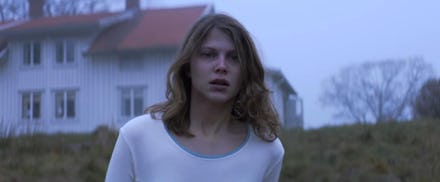‘Thelma’ isn’t just a “lesbian horror movie.” It’s a story of love and self-acceptance.

In one scene from the new Norwegian thriller Thelma, the titular young woman is studying in her Oslo university’s library when she encounters another student. There’s something about her, this other student, that stirs feelings in Thelma that she’s never had before. And all of a sudden, those feelings manifest into something disturbing: birds fly into glass, lights flicker and Thelma falls to the ground, seizing and convulsing.
Thelma (played by Eili Harboe) doesn’t understand what’s happening to her, but she quickly comes to realize that her attraction to another woman is causing her to react violently out of her own control, with supernatural results. Up until this point, Thelma has led a sheltered life, with strict, controlling parents who’ve raised her within their religious ideals. Now, stepping out into the real world, she’s beginning to discover who she is as a person, as a woman, as a sexual being and as something more powerful and perhaps more dangerous than she ever knew.
Director Joachim Trier has proved with his previous films — particularly 2011’s Oslo, August 31st and 2015’s Louder than Bombs — that he’s got a knack for portraying heavy subject matter (drug addiction, suicide, loss) with a subtle, humanist touch. With Thelma, he’s turned to the stylized world of genre. But rather than make a standard supernatural erotic thriller that’s focused on gore and scares, Trier’s approach is to use the striking imagery to dig deeper into his characters. He and his Thelma co-writer Eskil Vogt unearth the roots of sexual repression and the pain it causes.
The idea for the film, which opens in the U.S. on Friday, started simply enough, Trier told Mic at the Toronto International Film Festival in September, after the film’s North American premiere. He and Vogt wanted “to conjure up deeper nightmarish images” inspired by the Japanese comics and Stephen King novels they loved as kids.
Looking for inspiration in how tell the story, Trier said he turned to the painter Edvard Munch, about whom he’s currently making a documentary with writer Karl Ove Knausgård. While Munch is most famous for his iconic painting “The Scream,” much of his work touches upon the Norwegian connection to myth, femininity and sexuality, often focusing on “the innocence and beauty of naked women walking through mystical woods into lakes,” as Trier put it. “It’s highly erotic and highly scary.”
Another huge inspiration for Trier’s approach to Thelma was George A. Romero’s “great feminist movie,” 1972’s Season of the Witch. “I wanted to be a part of that tradition,” Trier said. “I didn’t want to be a part of, like, screaming young women being victimized. I wanted there to be a strong female lead.”
Because Trier and Vogt didn’t want the film to be one-dimensional, they also avoided some of the horror genre’s more traditional trappings. “I hope people don’t see it as a copout that it’s not full of blood and guts,” Trier said. “But I think the loss of control, both of the human mind and the body, is one of my worst nightmares.”
A loss of control, and then regaining it, is what Thelma is about at its core. That conflict plays out in the protagonist’s rebellion against her religious upbringing. “If I am being critical of something, it’s how religion can be used as a power structure, a function to suppress, and historically, particularly [suppress] women or people who are gay,” Trier said.
In the film, Thelma’s parents use religion as a cudgel — a means to beat her natural and supernatural impulses into submission. They rely on religion as a tool to keep Thelma from being who she actually is. And it’s not like that sort of strict religious practice is foreign to Norwegians in real life. “In Norway, gay marriage in church is OK, so it’s kind of liberal,” Trier explained. “But there are still these kinds of extreme west coast Bible Belt environments that are growing at the moment.”
Thelma isn’t an easy screed against religion, though. “This is a film about the freak in all of us, and wanting to belong, and not having to suppress our real needs and our real passions, and the erotic things that are part of humankind that often in the ‘proper’ culture are being suppressed or stigmatized,” Trier said.
Thelma’s self-discovery is layered: Her revelations about her powers are concurrent with her learning about her sexual orientation and, later, her firm coming out. Trier’s goal for the film always remained very simple and very human. “I wanted to tell a story about the love and passion of young people,” he said. “Thelma is 20 years old, and she’s trying to figure herself out, and it’s such a pure existential moment for people to experience that big first love.”
The film’s commitment to that love and passion stands apart from what some might expect from a “lesbian horror movie.” Thelma comes to understand these feelings aren’t some evil that’s taking hold of her — she recognizes them as beautiful parts of herself.
Regaining control over one’s own truth, Thelma suggests, means facing our deepest fears about ourselves. For Trier, the true horror is not who we are, but the forces that try and prevent us from being that person.